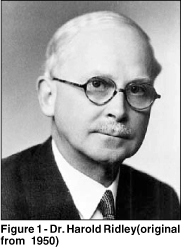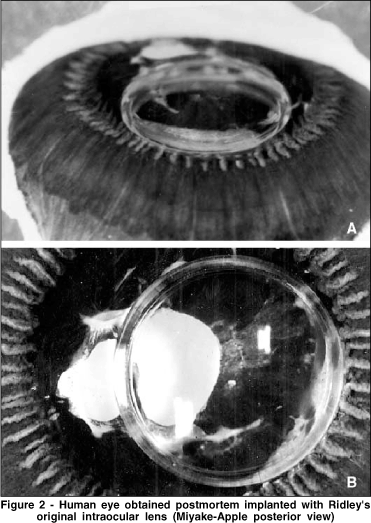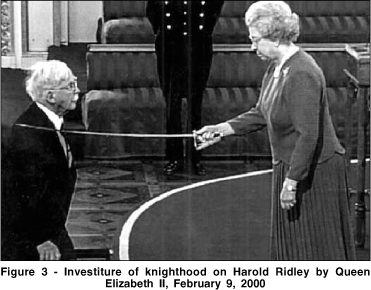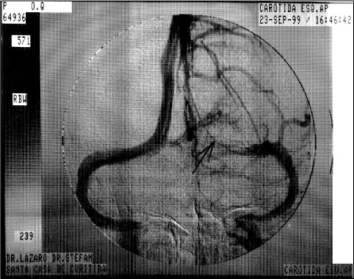

David J. Apple¹1; Liliana Werner1; Leonardo P. Werner3
DOI: 10.1590/S0004-27492002000100025
"He changed the world ¾ So that we might better see it"
David J. Apple1, Liliana Werner2, Leonardo P. Werner3
In addition to the military victories achieved by the allies in the World War II, the seeds for an unrelated but equally significant medical victory were sewn - an eventual conquest over many types of blindness. During that and later battles a series of brilliant observations were made by an enlightened individual, observations that eventually formed the basis for an innovation that has turned out to be one of the most monumental medical discoveries of the 20th Century. An invention, the intraocular lens, emerged that has vastly improved the treatment that physicians are able to provide to visually disabled or blind patients. Without exaggeration, it has led to the cure of multi-millions of visually handicapped individuals worldwide - a huge step towards the eradication of blindness. In addition, and of course unbeknownst to the inventor, his invention is now, a half century later, being applied in combination with high technology systems based on new computers and software that has the potential to restore vision to literally any blind eye, regardless of cause or severity.
A young British eye surgeon named Nicholas Harold Ridley, made these astute observations while treating injured pilots during this conflict (Figure 1). He had duty at the Alderholt Royal military facility in the south of England in 1940, where military casualties were treated as the enemy invaded from the south. Subsequently, and directly as a result of this an other scientific accomplishments he was knighted and thereafter referred to as Sir Nicholas Harold Ridley. He became one of the very few eye physicians ever to receive Knighthood, which was belatedly conferred upon him by Queen Elizabeth II of England on February 9, 2000. Sadly, the world of medicine is now mourning Sir Harold's death. He passed away on May 25, 2001 near his home in Salisbury, Wiltshire, England, one month prior to his 95th birthday.

During and after the Battle of Britain Ridley and his colleagues treated many pilots, mostly British and Canadians, but also captured Germans, who suffered battle casualties. Some had eye injuries in which fragments of broken plastic (Plexiglas) from their plane's cockpit, shattered by gunfire, penetrated into the pilot's eye. As the war passed and as he continued to encounter some of these injured pilots, all of his observations and thought processes gradually coalesced and he had two inspired moments of genius: First, he noted that even after severe injuries with eye perforations, massive hemorrhages and the like, these plastic fragments could be well-tolerated when embedded within the eye as long as the edges were not sharp and jagged. Furthermore, as these pilots were followed over the next decade he noted that the eyes would remain healthy over the long-term as long as the plastic foreign material did not chafe or scrape against the tissues within the eye. Based on these clinical observations, his second moment of inspiration then emerged: he proposed what was for that time a bold and totally mind-boggling idea - that it might be possible to intentionally surgically implant a plastic artificial prosthesis into the interior of the eye in order to help cure blindness from varying diseases.
Based on experiences with the cockpit fragments, Ridley reasoned that a tiny, well-manufactured, properly sized and shaped, and smoothly polished plastic device, when inserted into a patient's diseased eye, could provide a replacement for critical tissues damaged by disease or trauma. The most common disease or indication for this is the condition affecting the natural lens within our eyes that help us focus light. As all of us age, especially after long-term exposure to sunlight, our natural lenses become cloudy - clinically termed a cataract. For the first time in history a vision-restoring implant or artificial intraocular lens (IOL) was conceived!
Ridley mulled over these thoughts for many years and about 1947 he quietly and secretly accelerated completion of his research. He worked on the project with exquisite care and secrecy in order to forestall any commercialism. Also, since the idea was so new and indeed radical, he wanted to fully develop a safe design before any attempt at implantation in humans. Sir Harold did the first implantation of his device on a human patient in London in 1949, a female nurse volunteer who was blind in one eye; the rest is history. Although his invention was almost immediately shunned, belittled and outright rejected by many as too radical and too dangerous, i.e "placing a foreign body in the eye," an object "that would be rejected by the body's immune system," Ridley's invention nevertheless became available to millions of patients worldwide. Suddenly the scourge of cataract, the world's most common cause of blindness, could be cured.
During our collaboration we had the opportunity to evaluate the actual clinical/surgical case history of one the original Word War II pilots who survived until 1998 ¾ which provided an interesting follow-up to this fascinating story (Figure 2). In 1989, during one of Ridley's several visits to Charleston, Dr. James Edwards, then President of the Medical University of South Carolina and myself presented him with an honorary doctors degree (Doctor of Humane Letters ) in behalf of MUSC. Thereafter his fame proliferated and he was finally recognized and honored during the final decade of his life (Figure 3). In 1999 he was chosen in a worldwide election of his peers as one of the 10 Most Influential Ophthalmologists in history and was elected to the Ophthalmology Hall of Fame at one of our most important international ophthalmology meetings. Ridley is a modest giant of science. Based on his accomplishments in his chosen field of ophthalmology he clearly ranks with the likes of Thomas Edison, Albert Einstein, or Jonas Salk as an indisputable leader - indeed a hero - in his specific field.


His discoveries now potentially affect virtually all human beings, ranging from persons who wear contact lenses made from various plastics that he and his colleagues had studied to over 6.000.000 individuals annually worldwide who have their vision restored with the Ridley-cataract-IOL-operation. Unfortunately there are still over 25.000.000 unoperated people with cataracts in poor countries around the world, who as of yet cannot receive this treatment because of financial/logistical reasons.
Ridley's invention is of much more than historical interest. It is now possible to take plastic implants analogous to his designs and embed high technology micro-devices such as silicone microchips micro-telescopes, mini-cameras and the like, into them. These can then receive light and images from the environment and transmit, visual impulses to a blind person's brain, thus at least partially restoring vision. With such gadgetry it would be possible to treat blindness of all possible conditions and diseases, for example, macular degeneration and retinitis pigmentosa, glaucoma, destruction of the eye by severe eye trauma and many others. This is the concept of the "eye transplant" or "bionic eye" (see USA Today "Tiny Chip May Restore Vision to Patients", by Kathleen Fackelmann, August 1, 2001) that is now under intense research, including in our Center. Such futuristic devices that can be implanted in the eye are no doubt going to be developed and applied; complete eradication of blindness - only a dream until now - will become a reality. Ridley's contribution has been to provide the needed break-through towards successful intraocular prosthesis implantation.
In large part because of his invention, the last half-decade of the 20th century has been termed by some the Golden Age of ophthalmology and the visual sciences. Patients today can be cured by techniques related back to Ridley's insight that require only a few minutes intervention, this in sharp contrast to 7 to 10 day hospitalizations required after surgery in earlier times. Most patients are operated on as outpatients without need for hospitalization. Institutions and asylums for the blind are largely a relic of the past. As late as 1990 there were 15 overnight hospital beds for eye patients on the 4th floor of the Storm Eye Institute. Today there are none!
As we say goodbye to Sir Harold, I would hope that each time any of us or our loved ones become afflicted with any visual problem, however minor, we will reflect back on that summer of 1940 and be grateful not only for our freedom, but also for the sight-saving invention that rose out of the wreckage of that conflict. All of us who have had the experience of relatives or friends (or ourselves!) having, for example, an intraocular lens implant after surgery, based on Ridley's "tiny piece of plastic" should also remember the role of Charleston in bringing Ridley's genuine "miracle" to fruition. The generation of the second half of the 20th Century have already benefited from Ridley's contribution and I predict, as high technology develops further, that citizens of the 21th Century and onwards will benefit even more.
His discovery has indeed changed the world so that we might better see it with our eyes. It has brought forth a miracle by helping all of us see better by preserving our gift of sight. Even when a miracle might appear to become routine over time, it still remains a miracle.
Ambliopia: Deficiência visual com cumplicidade
Há longo tempo, nós oftalmologistas temos como problema comum a desorientação com que agem os pediatras com relação ao estrabismo e conseqüentemente à ambliopia em seus pequenos pacientes. Conceitos totalmente errados, que ninguém sabe de onde surgiram, tais como: "o estrabismo da criança pequena é fisiológico e desaparece com a idade"; "ainda é cedo para um exame oftamológico"; "deixe a criança crescer um pouco para se poder tratar" e outros, são passados aos responsáveis pela criança. Esta conduta incorreta torna o profissional um "cúmplice" da deficiência visual futura de seu paciente e até responsável por ela. Encaminhar o paciente para o oftalmologista em tempo hábil é o mínimo que pode fazer.
Que esta "cumplicidade culposa" dos pediatras decorra da falta de orientação e de conhecimento sobre o assunto, fatos inaceitáveis nos dias de hoje, demonstra apenas a falta de formação que sabemos existir na maioria das escolas médicas do país. No entanto esta mesma cumplicidade com a deficiência visual produzida por estrabismo e/ou ambliopia, partindo de oftalmologistas é no mínimo uma "cumplicidade dolosa" pois demonstra apenas irresponsabilidade e não falta de conhecimento, pois se este fosse o fato, este profissional deveria pelo menos não se dizer especialista.
Sabemos da condição atual de super-especialização precoce na formação do oftalmologista, que vem preparando profissionais em muito incompletos. Entretanto é fundamental que haja honestidade de conduta não só para benefício do paciente, como para a classe oftalmológica em geral. Hoje em dia ninguém é obrigado a atender o paciente se sentir incapaz, porém no momento que o atende, é o responsável por ele e deste modo, pelos bons e maus resultados em seu tratamento.
Não podemos mais, dentro do nível que atingiu a oftalmologia brasileira, continuar a receber pacientes que passaram vários anos em refrações sucessivas com colegas conceituados (??) sem que siquer orientasse uma oclusão ou controle do desvio, ou o que é pior, nunca medisse a acuidade visual da criança.
É necessário que estes profissionais, que só nos encaminham os pacientes aos 6 ou 7 anos com o objetivo de cirurgia notem que é nesta fase, quando os familiares tomam conhecimento da deficiência que poderia ser por ele evitada, e que não foi por imperícia ou por negligência de sua parte, que ele além de perder este paciente, perde também a confiança e angaria campanha negativa em torno de seu nome, que é bastante freqüente e muito desmoralizadora.
Isto sem falarmos de sua culpa na manutenção de uma deficiência visual (se é que isto afeta sua consciência), o que contraria os mais básicos preceitos da Medicina.
Renato Curi
Prof. Titular de Oftalmologia
Universidade Federal Fluminense
Curitiba, 8 de janeiro de 2002.
Referente ao artigo:
"Paresia bilateral assimétrica de nervo troclear associada a trombose de seio transverso pós-otite"
Prezado Dr. Harley Bicas,
Rediscutimos o caso com os preceptores do departamento de Neurologia, que confirmaram que a trombose de seio transverso é uma complicação quase exclusiva de otite média aguda ou crônica. Comumente a trombose ocorre do mesmo lado da infecção, por contiguidade ou desenvolvimento de um coágulo infectado na luz do seio. No caso em estudo, a trombose ocorreu do lado oposto à otite provavelmente em decorrência de disseminação de um coágulo por uma outra via, como uma variação anatômica, ou pelo desenvolvimento de meningite bacteriana (complicação da otite) no início do quadro, mascarada pela antibioticoterapia dirigida à otite. Esta meningite levaria a uma inflamação na fossa posterior que possibilitaria o desenvolvimento de uma trombose do seio transverso à esquerda.
A angiografia que mostra a trombose se encontra em anexo. O laudo a ela referente diz o seguinte: "a artéria carótida esquerda exibe em seu segmento encefálico bom calibre, não observamos lesões obstrutivas na fase arterial. Na fase venosa, não observamos contrastação do seio transverso esquerdo, com drenagem vicariante à direita. Conclusão: trombose venosa à esquerda."
Atenciosamente
Ana Tereza Ramos Moreira
Nota Editorial
A figura refere-se ao trabalho "Paresia bilateral assimétrica de nervo troclear associada a trombose de seio transverso pós-otite" publicado no vol. 64, nº 2, p. 153-5, 2001.

Center for Research on Ocular Therapeutics and Biodevices (Director: David J. Apple ), Storm Eye Institute, Medical University of South Carolina, Charleston, South Carolina, USA.
1 Fellow, American Ophthalmological Society, Professor of Ophthalmology and Pathology, Pawek-Vallotton Chair of Biomedical Engineering, and Director of the Center for Research on Ocular Therapeutics and Biodevices at the Storm Eye Institute, MUSC, Charleston, SC, USA
2 Assistant Professor, Storm Eye Institute, MUSC, and Senior Scientist, Center for Research on Ocular Therapeutics and Biodevices
3 Assistant Ophthalmologist of the Cornea and Cataract division of the São Geraldo Hospital, Federal University of Minas Gerais, Belo Horizonte, MG, Brazil, Director of the OftalmoCenter of Manhuaçu, MG, and former Research Fellow of the Center for Research on Ocular Therapeutics and Biodevices
Correspondence and reprints requests to: Liliana Werner, Storm Eye Institute, Department of Ophathalmology, Medical University of South Carolina, 167 Ashley Avenue, P.O. Box 250676, Charleston, SC, 29425-5536, USA. Phone: (843) 792-0777; fax: (843)792-7920; E-mail: [email protected]